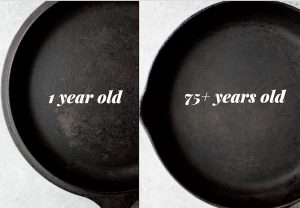CLEANING TIP SEARCH
Find your cleaning solution below
STEP BY STEP GUIDE TO CAST IRON CARE AND CLEANING
STEP BY STEP GUIDE TO CAST IRON CARE AND CLEANING
 Today I am going to take you through the steps to clean, season and remove rust and corrosion in cast iron. If you follow this guide your cast on pan will last for decades.
Today I am going to take you through the steps to clean, season and remove rust and corrosion in cast iron. If you follow this guide your cast on pan will last for decades.
REMOVING RUST AND CORROSION FROM CAST IRON
Remove all the rust: Use fine steel wool to remove rust from affected areas. Scour the skillet until the area returns to raw cast iron.
Wash the skillet thoroughly: Wash the cast iron with warm water and mild dish soap. Scrub with bristle brush, gentle scouring pad, or mesh sponge if needed.
Dry the skillet: Thoroughly dry the cast iron immediately with a clean dish towel or paper towels.
Cover the pan with a coating of oil: Apply a small amount of vegetable oil (or cooking oil of choice) to the entire piece.
Don’t forget the bottom and handle: When oiling, don’t forget the bottom and handle. Use only a small amount to avoid a sticky surface.
Place the pan in the oven: Place the cast iron upside down on the top rack of your rack. Place a sheet of aluminum foil or a foil-lined baking sheet on the bottom rack to catch any oil drips. Heat the cast iron for one hour at 350 degrees.
Let the pan cool before using: Turn off heat, let cast iron cool, then get back to cooking!
SEASONING CAST IRON
What is Seasoning?
Seasoning is simply oil baked onto the iron that prevents rust and provides a natural, easy-release finish that continues to improve with use. Seasoning can refer to both the initial finish of the cookware as well as the ongoing process of maintaining that finish.
About the Oil
All cooking oils and fats can be used for seasoning cast iron, but based on effectiveness and having a high smoke point, I suggest vegetable oil, melted shortening, or canola oil.
It is very important to maintain the seasoning of your cast iron and seasoned steel cookware by applying a very thin layer of oil after each cleaning. This will help keep you cooking for decades.
If the seasoning on your pan is sticky, this is a sign of excess oil building up and not fully converting to seasoning. To remedy this, place the cookware in the oven, upside down on the top rack and bake at 350 degrees for 1 hour. Allow to cool and repeat if necessary.
CLEANING A CAST IRON SKILLET
Instructions for cast iron skillet cleaning often include a lot of DON’Ts : Don’t use soap, don’t use steel wool, don’t put it in the dishwasher. Actually it’s easy to care for and done right will last forever.
Clean the skillet immediately after use, while it is still hot or warm. Avoid soaking the pan or leaving it in the sink, or it may rust.
Wash the skillet by hand using hot water and a sponge or stiff brush. Avoid using the dishwasher, soap, or steel wool, as these may strip the pan’s seasoning.
To remove stuck-on food, scrub the pan with a paste of coarse kosher salt and water. Stubborn food residue may also be loosened by boiling water in the pan.
Thoroughly towel dry the skillet or dry it on the stove over low heat. I prefer to dry it on low heat. Keep an eye on it, however, so you don’t forget it. It only takes minutes to dry over heat.
Using a cloth or paper towel, apply a light coat of vegetable oil or melted shortening to the inside of the skillet. Some people also like to oil the outside of the skillet. Buff to remove any excess. Store the skillet in a dry place. Avoid stacking other pans etc in it. I always store with a piece of wax paper in it.
REGULAR CLEANING FOR CAST IRON
Clean the skillet immediately after use, while it is still hot or warm. Avoid soaking the pan or leaving it in the sink, or it may rust.
Wash the skillet by hand using hot water and a sponge or stiff brush. Avoid using the dishwasher, soap, or steel wool, as these may strip the pan’s seasoning.
To remove stuck-on food, scrub the pan with a paste of coarse kosher salt and water. Stubborn food residue may also be loosened by boiling water in the pan.
Thoroughly towel dry the skillet or dry it on the stove over low heat.
Using a cloth or paper towel, apply a light coat of vegetable oil or melted shortening to the inside of the skillet. Some people also like to oil the outside of the skillet. Buff to remove any excess.
Store the skillet in a dry place. I like to store with a piece of wax paper inside, to protect the pan and the seasoning.

